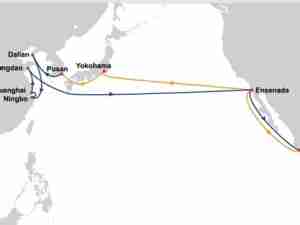Compared to business volume two years ago, North Carolina's Ports show a 44.5% increase.
"We are working hard to improve our equipment, facilities and operations to accommodate both the remarkable, current growth ' and especially the continuing growth we anticipate in the near future," said Carl J. Stewart
Jr., Chairman of the NC State Ports Authority's Board of Directors. "We are actively positioning North Carolina's Ports to meet market demand forecast for five years out and beyond with our $265 million expansion program."
Wilmington's breakbulk tonnage increased 21 percent, setting a new record at 1.6 million tons after the previous record of 1.05 million tons last year. At Morehead City, breakbulk tonnage soared 47% from 215,000 tons in fiscal 2004 to 315,400 tons this year.
Nearly 73,000 container moves at Wilmington marked a 37% increase over last year's 53,400 moves. Both the 42-foot navigation channel, opened in 2004, and burgeoning international trade fueled the growth in container activity at the Port.
"This is the first full fiscal year our customers have been able to move additional business with the extra channel depth at Wilmington," said Ports Authority CEO Tom Eagar. "Our current container service to southern China saw a significant increase in business, and we welcomed a new service to northern China in February."
Two commodities drove the remarkable growth in breakbulk volumes at the Ports. (Breakbulk refers to commodities that are shipped in units, in contrast to bulk cargo such as fertilizer or salt.) Import lumber climbed 49% at Wilmington and was a significant line of new business at Morehead City. Since Gearbulk, one of the world's largest forest products carriers, began service to Morehead City in February, its vessels have unloaded 45,000 tons of lumber, primarily used in construction.
Steel also recorded impressive growth at the Ports 'more than doubled at Wilmington and nearly doubled at Morehead City. While Wilmington's steel business is all import, Morehead City saw increases in both import and export steel.
Bulk products also contributed significantly to business growth at both Ports. At Wilmington, fertilizer imports rose 25%, cement imports 84% and salt imports 140%. At Morehead City, imports of colemanite ore used to manufacture fiberglass products increased 22%, and import fishmeal for animal feeds jumped 41%. Phosphate exports from Morehead City have jumped more than 68% in two years.
"North Carolina citizens across the State enjoy thousands of jobs and millions of dollars in tax revenues from activities at our Ports of Wilmington and Morehead City," Mr. Stewart said. "We see clearly the importance of our role in the state's economic development efforts, and our leaders both in the General Assembly and in Congress have recognized that importance with investments in infrastructure and facilities at Wilmington and Morehead City," he continued, and "we will keep showing them what a good idea those investments are."






